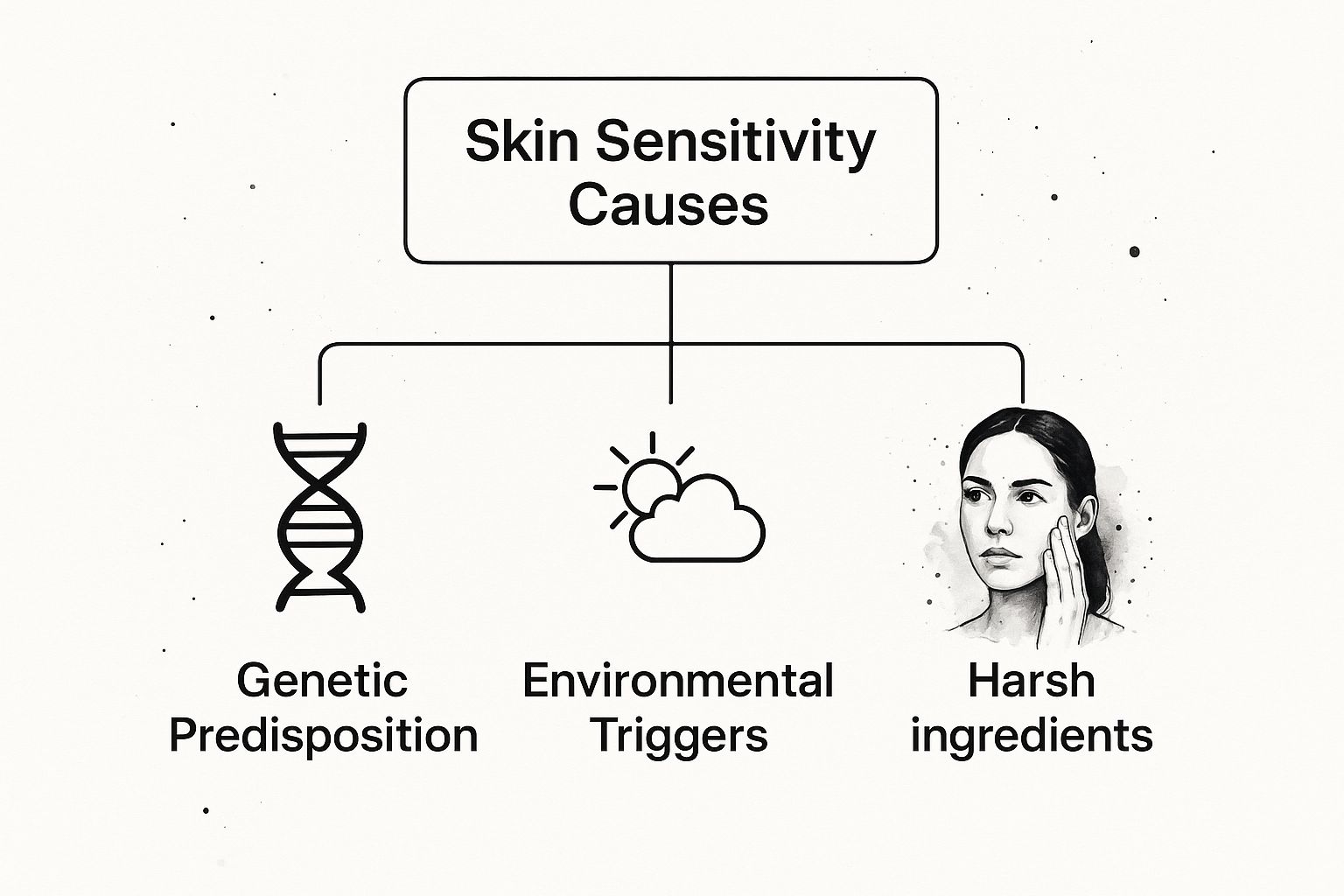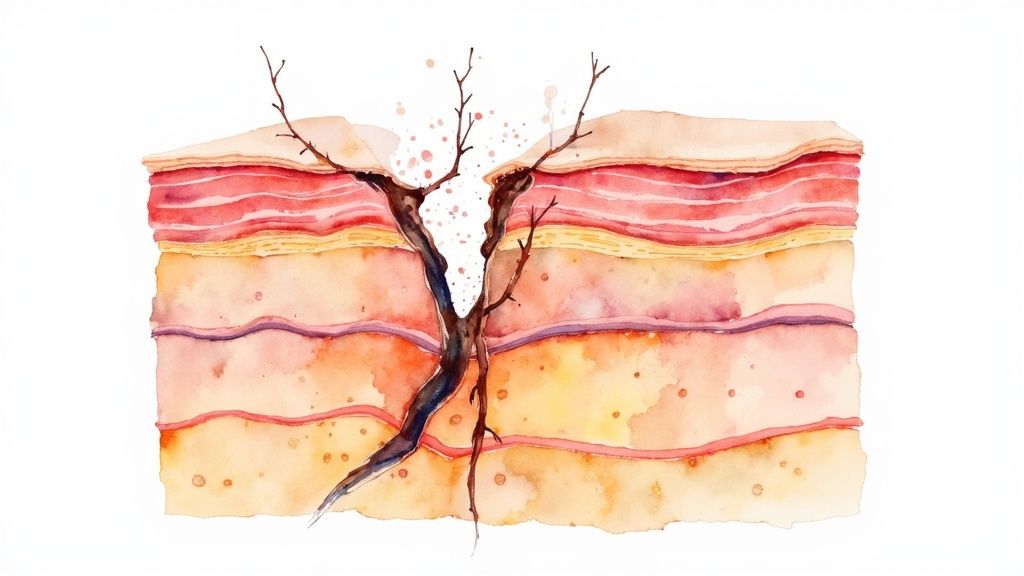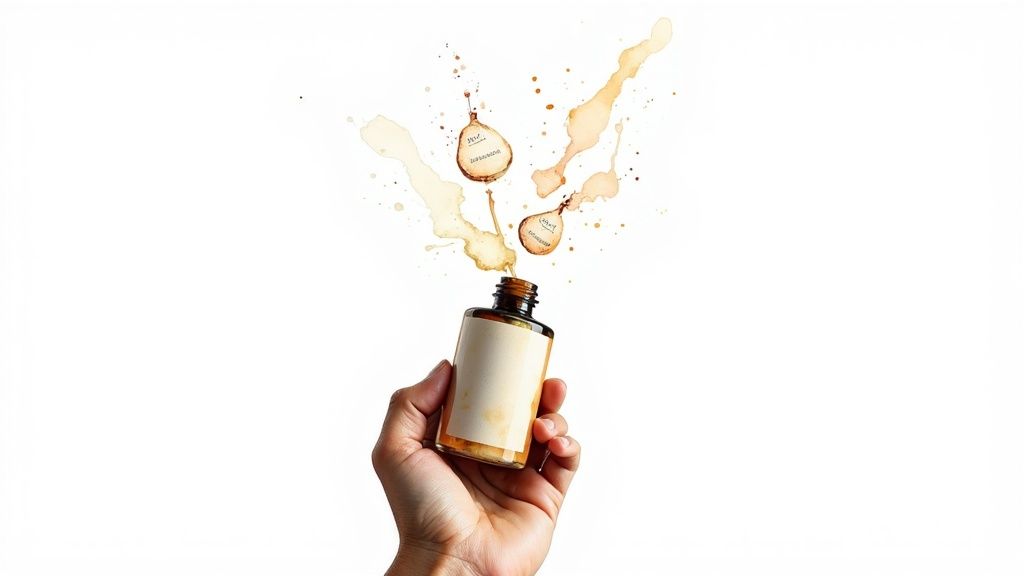
What Causes Skin Sensitivity? A Complete Guide
If you've ever wondered why your skin suddenly feels tight, itchy, or looks red after using a new product or even just stepping outside, the answer usually comes down to one thing: a compromised skin barrier.
At its core, skin sensitivity happens when your skin's natural defense system gets weakened. The most helpful way to picture this is to think of your skin as a sturdy brick wall. The skin cells are the bricks, and the natural lipids (oils) are the mortar holding everything together. A healthy, strong wall keeps irritants and pollutants out while locking precious moisture in.
But when that mortar starts to crumble? That's when trouble begins. Gaps form, allowing irritants to sneak in and water to escape, leading to that all-too-familiar stinging, redness, and discomfort.
Unpacking the Causes of Skin Sensitivity
Let's use another analogy. Imagine your skin barrier is a highly effective security guard for an exclusive event. When it's working properly, it has no problem keeping troublemakers (like allergens, bacteria, and harsh chemicals) out on the street. At the same time, it makes sure all the important guests—namely, moisture and essential nutrients—stay inside where they belong.
A sensitive skin barrier is like an overworked, tired security guard. It can't keep up, the perimeter is breached, and chaos breaks out. This breakdown is the real reason behind skin sensitivity, turning harmless things like a change in weather or a new lotion into a full-blown flare-up.
These reactions aren't random. They're triggered by specific factors that chip away at that protective shield. Getting to know these triggers is the first, most crucial step toward calming your skin and helping it rebuild its defenses.

As you can see, sensitive skin rarely stems from a single problem. It’s usually a mix of what you're born with, what your skin faces every day, and the choices you make.
The Three Pillars of Skin Sensitivity
To really get a handle on what’s going on, it helps to group the causes into three main categories. Each one plays a distinct role in weakening your skin’s natural defenses.
Biological Blueprint: This is all about your internal wiring—genetics and body processes. Some of us are just born with a naturally thinner or less resilient skin barrier. It also includes predispositions to inflammatory conditions like eczema and rosacea, which go hand-in-hand with sensitivity. Even internal factors like hormonal fluctuations and high stress levels can weaken your skin from the inside out.
Environmental Aggressors: Your skin is your first line of defense against the outside world, and it takes a beating. Sun exposure (UV radiation), extreme hot or cold temperatures, biting winds, and low humidity from air conditioning or central heating all do a number on your barrier. Add in daily urban pollution, and you have a recipe for stripped natural oils and oxidative stress.
Lifestyle and Product Choices: This is the category you have the most control over. The products you use every day can either help or hurt. Harsh, stripping cleansers, over-exfoliating with scrubs or acids, and using skincare loaded with potential irritants like fragrance and certain alcohols can directly dismantle your skin’s protective barrier. Don't forget that what you put in your body matters, too—dehydration and a diet high in inflammatory foods can absolutely show up on your skin.
To make it even clearer, here’s a quick rundown of the primary triggers that can send your skin barrier into a tailspin.
Primary Triggers That Weaken Your Skin Barrier
This table gives a quick overview of the internal and external factors that can compromise your skin's natural defenses, leading to sensitivity.
| Factor Category | Specific Triggers | How It Impacts Your Skin |
|---|---|---|
| Biological | Genetics, hormonal shifts, stress, conditions like eczema or rosacea. | Predisposes the skin to a weaker barrier structure and higher inflammation. |
| Environmental | UV radiation, pollution, extreme temperatures, low humidity, hard water. | Physically strips away protective lipids and creates free radical damage. |
| Lifestyle | Harsh cleansers, over-exfoliation, irritating ingredients, poor diet, dehydration. | Directly damages the barrier, allowing irritants in and moisture out. |
By understanding how these different pillars work together, you can start to identify your personal triggers and take targeted steps to rebuild a stronger, healthier, and much happier skin barrier.
Your Body's Natural Blueprint for Sensitivity

Sometimes, the root of skin sensitivity isn’t about a product you used or something you did wrong—it's just how you're built. For many people, sensitive skin is a biological reality written right into their DNA, dictating everything from the strength of their skin barrier to how their immune system reacts to the world.
Think of it like being born with fine hair instead of thick hair. Some of us simply have a genetic predisposition for a skin barrier that's naturally thinner or just not as great at holding onto moisture and keeping irritants out. This built-in blueprint can make you more prone to dryness, redness, and general irritation right from the get-go.
The Genetic Connection to Skin Reactivity
Often, chronic skin sensitivity can be traced back to our genes. If you or your family have a history of conditions like eczema, rosacea, or psoriasis, your skin is likely hardwired to be more reactive. These are all rooted in an overactive immune response and inflammation, which directly chip away at the skin’s defenses.
The link here is incredibly strong. At its core, sensitive skin is defined by unpleasant reactions like stinging or itching to things that shouldn't bother it. It's really no surprise then that people who describe their skin as extremely sensitive are 200% more likely to have been diagnosed with disorders like eczema or rosacea. Their skin is already on high alert. You can discover more insights about the prevalence of sensitive skin and its deep connection to these conditions.
How Hormones and Stress Tip the Scales
Genetics isn't the whole story, though. Your body's internal chemistry plays a huge part in how your skin behaves. Hormonal fluctuations are a perfect example, capable of turning perfectly calm skin into a reactive mess almost overnight.
These shifts often pop up during key life stages:
- Menstruation: Just before your period, an increase in hormone-like substances called prostaglandins can ramp up inflammation.
- Pregnancy: The surge of hormones can throw your skin’s oil production and sensitivity levels for a loop.
- Menopause: As estrogen levels decline, skin becomes thinner, drier, and far more vulnerable to irritation.
Stress is another massive internal trigger. When you're feeling frazzled, your body pumps out cortisol, the main stress hormone. Consistently high cortisol levels can weaken the skin barrier, trigger inflammation, and slow down your skin's natural repair process. This makes your skin an easy target for flare-ups. It’s not just in your head—it’s a direct physiological response that profoundly impacts your skin's health.
How Your Environment Affects Your Skin

While your genes might load the gun for sensitive skin, it's often your environment that pulls the trigger. Your skin is constantly interacting with the world, and many outside forces can chip away at its protective barrier, paving the way for redness, itching, and general reactivity.
Pinpointing these environmental triggers is a huge step toward getting your sensitive skin under control.
Imagine your skin’s barrier as a perfectly sealed brick wall, with skin cells as the bricks and natural lipids as the mortar holding it all together. Harsh weather acts like a pressure washer, blasting away that crucial mortar. Biting winter winds and bone-dry air literally suck the moisture out, leaving your skin feeling tight, flaky, and exposed. On the flip side, intense summer heat and sun can be just as damaging, leading to dehydration and a weakened defense system.
It's not just a feeling, either. One study found that 36% of people with sensitive skin point to extreme hot or cold temperatures as a direct cause of their flare-ups.
The Invisible Damage From Sun and Pollution
We all know the sun is a major player, but its impact goes far deeper than a visible sunburn. Ultraviolet (UV) radiation unleashes a storm of free radicals—these are rogue molecules that damage healthy skin cells and break down the collagen that keeps your skin firm. This process, called oxidative stress, relentlessly weakens your skin barrier, making it far more likely to overreact to just about anything. If you're already seeing the effects, our guide on how to reverse sun damage can help you start the repair process.
City living presents its own unique set of challenges. Airborne pollutants from traffic and industry are tiny enough to sneak past your skin's defenses.
Think of these microscopic particles like tiny invaders. They trigger oxidative stress, just like UV rays, putting your skin in a state of constant, low-grade inflammation. This is a defining characteristic of sensitive skin, keeping it on high alert and ready to react at a moment's notice.
Indoor Environments and Sneaky Triggers
Your environment doesn’t become neutral just because you're indoors. Central heating and air conditioning are notorious for creating desert-like conditions. This artificial dry air constantly leeches moisture from your skin, compromising its barrier while you're just sitting at your desk or relaxing at home.
And it’s not just the air. Several other common factors can play a role:
- Hard Water: That high mineral content in your tap water can leave a film on your skin, disrupting its delicate pH balance and leading to dryness.
- Chlorine: A dip in the pool can be refreshing, but chlorine is designed to be harsh. It strips away your skin’s protective oils, often causing irritation.
- Sudden Temperature Shifts: Ever walk from the freezing cold into a warm shop and feel your face flush? That abrupt change can be a shock to your system, triggering redness and discomfort.
By understanding how these daily exposures—from the weather report to the thermostat setting—affect you, you can start building a smarter defense. Protecting your skin from these aggressors is the key to maintaining that crucial barrier and finally achieving a calmer, more resilient complexion.
The Impact of Your Daily Habits and Choices

While you can’t change your genes or the weather, the small choices you make every single day often have the biggest and most immediate impact on how your skin feels. What you put on your body—and in it—can either build up your skin’s defenses or help tear them down. Getting a handle on these connections is the first real step toward taking back control.
So many common skincare habits are actually secret culprits behind irritation. Imagine your skin barrier is like a finely woven piece of silk. Every time you use a harsh, stripping cleanser or blast your face with scalding hot water, you’re essentially fraying those delicate threads. Over-exfoliating with gritty scrubs or powerful acids is another major offender, as it physically strips away the protective oils and lipids your skin is desperate to hold onto.
Your Skincare Cabinet Under a Microscope
The products lining your bathroom shelves can be a total minefield for sensitive skin. It’s frustrating, but many are packed with ingredients known to cause reactions, even if they seem fine for the first few uses. This is why learning to read labels isn't just a good idea—it's non-negotiable for achieving calmer skin.
Keep an eye out for these common troublemakers:
- Fragrances: This is a big one. Both synthetic perfumes and natural essential oils are consistently ranked among the top causes of skin reactions.
- Harsh Alcohols: Look for ingredients like denatured or SD alcohol. They give products a quick-drying feel but can strip your skin’s natural moisture, leading to dryness and irritation.
- Sulfates: Often found in cleansers that foam up a lot, ingredients like Sodium Lauryl Sulfate (SLS) can be far too aggressive for an already compromised skin barrier.
If your skin constantly feels tight, red, or itchy after you've finished your routine, that's a massive red flag. It’s your skin telling you that something needs to change. Finding the right products is a game-changer, and our guide on how to calm irritated skin offers practical steps to soothe your complexion right away.
How Diet and Lifestyle Choices Fuel Sensitivity
But what causes skin sensitivity isn't just about what you slather on your face. Your diet and daily habits create the internal environment that your skin ultimately reflects. A diet heavy in processed foods, sugar, and for some people, dairy, can kickstart systemic inflammation. That internal fire often shows up on your skin’s surface as redness, breakouts, and general reactivity.
Dehydration is another sneaky trigger. When you don't drink enough water, your skin can't function at its best. Its natural repair processes slow right down, and the barrier becomes brittle and much more vulnerable to damage from the outside world.
Even the world around us shapes our skin. One study, for example, found that people in certain areas had stronger skin reactions to spicy foods, likely because of what they were (and weren't) used to eating. It just goes to show how deeply our lifestyle is connected to our skin's health. You can learn more about these findings and how sensitivity is reported across different groups.
Finally, don't forget about your immediate surroundings. Simple things, like the laundry detergent you use or even the fabric you sleep on, can make a huge difference. Switching to a fragrance-free detergent is a great start, and exploring options like luxury bamboo bedding for sensitive skin can create a gentler environment while you sleep. Every little adjustment helps build a safer, more supportive world for your skin.
A Global Snapshot of Sensitive Skin
If you're dealing with sensitive skin, you're in good company—and that company is global. While it can feel isolating, skin sensitivity is a universal experience that transcends borders. What’s truly fascinating, though, is how different it looks from one corner of the world to the next, shaped by everything from the air we breathe to the food we eat.
It's far more common than you might think. In the United States, for instance, a staggering 44% of people say they have sensitive skin. This isn't some rare, niche problem; it's a reality for nearly half the population, and similar trends are seen worldwide.
Why Your Location Matters
The triggers that set off a reaction in someone living in a cold, dry climate can be completely different from what affects someone in a hot, humid one. This is where the story of sensitive skin gets interesting.
- The Climate Connection: Think about Northern Europe, where long, harsh winters and constant indoor heating strip moisture from the skin. The result? A weakened skin barrier that's prone to dryness and irritation. Now, pivot to Southeast Asia, where high humidity and urban pollution can lead to clogged pores and inflammation, another pathway to sensitivity.
- You Are What You Eat: Our diets play a huge role, too. Research has shown that populations with diets high in inflammatory foods often report more skin reactivity. On the flip side, cultures that emphasize anti-inflammatory foods, like those rich in omega-3s, tend to see different outcomes.
- Cultural Skincare Rituals: The way we care for our skin is deeply tied to culture. In some regions, complex, multi-step routines with powerful active ingredients are the norm. While this can be beneficial, it also raises the risk of over-exfoliation and irritation if not managed carefully.
The bottom line is that there's no single "perfect" routine. What works wonders for someone in a dry, desert climate could be a recipe for disaster for a person living in a bustling, polluted city. When it comes to skin, context is king.
The Gender Divide in Skin Sensitivity
Across continents and cultures, one pattern holds remarkably steady: women are more likely than men to report having sensitive skin. The numbers tell a clear story.
While the causes are complex, this gap is often chalked up to a mix of biology and behavior. Hormonal shifts throughout the menstrual cycle, pregnancy, and menopause can make female skin more reactive. On top of that, women have historically been the primary consumers of cosmetics and skincare, leading to greater cumulative exposure to a wide array of ingredients—and potential irritants—over a lifetime.
To get a clearer picture of these global and gender-based trends, let's look at the data side-by-side.
Reported Skin Sensitivity Prevalence By Country and Gender
This table provides a comparative look at the percentage of the population identifying as having sensitive skin across different regions, highlighting the consistent variation between women and men.
| Country | Total Prevalence (%) | Women (%) | Men (%) |
|---|---|---|---|
| United States | 44.6 | 50.9 | 38.2 |
| Europe (Overall) | 38.4 | 51.4 | 38.2 |
| United Kingdom | 44.8 | 51.4 | 38.2 |
| France | 59.0 | 66.0 | 52.0 |
| Brazil | 43.0 | 54.0 | 33.0 |
| Japan | 54.5 | 57.7 | 34.9 |
As you can see, the numbers fluctuate by region, but the trend of higher reported sensitivity among women is a common thread. For a deeper dive into these statistics, you can read the full research about these gender differences and their implications. This data not only confirms that sensitive skin is a widespread issue but also underscores how our individual experiences are part of a much larger, globally connected story.
A Practical Plan to Calm and Protect Your Skin
So, you've figured out why your skin is so reactive. That’s a huge first step. But now what? The key to managing sensitive skin isn't about finding one miracle cream; it's about building a consistent, gentle defense system.
Think of it this way: your two main goals are to strengthen your skin's protective barrier and to learn what sets your skin off. Get those two things right, and you're well on your way to a calmer, more resilient complexion. A few small, thoughtful adjustments in your daily life can make a world of difference in reducing that all-too-familiar redness, stinging, and discomfort.
Build a Simple, Soothing Skincare Routine
When your skin is already on high alert, the last thing it needs is a 10-step routine packed with powerful active ingredients. This is a time when less is truly more. Pare your routine back to the absolute essentials, focusing on products specifically designed for sensitive skin—that means no fragrances, harsh alcohols, or other common irritants.
Your entire routine can be boiled down to just three core steps:
Gentle Cleansing: Always wash your face with lukewarm water. Hot water feels nice, but it's a major culprit in stripping away the natural oils that keep your skin barrier intact. Opt for a mild, pH-balanced cleanser that leaves your skin feeling comfortable and soft, never tight or squeaky.
Strategic Hydration: The moment you pat your skin dry, apply your moisturizer. This timing is crucial for locking in moisture. Look for products packed with barrier-loving ingredients like ceramides, hyaluronic acid, and niacinamide. These are the building blocks that help replenish your skin’s lipid layer. We go into much more detail on this in our post on how to repair skin barrier.
Daily Sun Protection: The sun is a massive trigger for inflammation and sensitivity. A broad-spectrum, mineral-based sunscreen with an SPF of 30 or higher is non-negotiable, every single day. Yes, even when it’s overcast. Mineral formulas with zinc oxide or titanium dioxide are usually much kinder to reactive skin than their chemical counterparts.
Pro Tip: Always Patch Test. Before you slather a new product all over your face, test it out first. Apply a tiny amount to a hidden spot, like behind your ear or on your inner wrist. Wait a full 24-48 hours to see if there’s any redness, itching, or irritation. This simple habit can save you from a major flare-up.
Make Smart Lifestyle and Product Choices
What you do beyond your bathroom sink matters just as much. Makeup, for instance, can be a minefield for sensitive skin. Choosing products specifically formulated to be gentle is a game-changer. For a deep dive into this, check out a complete guide to hypoallergenic makeup for sensitive skin.
And don't forget the inside-out connection. Keeping your body hydrated by drinking plenty of water helps your skin function at its best. Managing stress is also huge, as high cortisol levels can fuel inflammation. Simple practices like meditation, a walk outside, or gentle exercise can make a real difference.
If you’ve tried all this and your skin is still struggling, it's time to call in a professional. A dermatologist can give you a proper diagnosis and create a personalized treatment plan to get you back on track.
Frequently Asked Questions About Sensitive Skin
When your skin seems to react to everything, it's natural to have a lot of questions. Getting clear, straightforward answers is the first step toward feeling in control of your complexion. Let's clear up some of the most common points of confusion.
Sensitive Skin Versus Allergic Reactions
It's so easy to mix these two up, but they’re actually coming from two very different places.
Think of sensitive skin as a more constant state of being. Your skin's protective barrier is just naturally a bit weaker, making it consistently prone to irritation from all sorts of things, like a cold wind or a new moisturizer. The reaction is usually on the milder side—think redness, tightness, or a stinging feeling.
An allergic reaction, however, is your immune system sounding the alarm. Your body has decided a specific ingredient is a threat and goes on the attack. This response is much more intense, often leading to hives, severe itching, and even swelling. Sensitivity is an ongoing characteristic; an allergy is a targeted, dramatic response to a single culprit.
The real giveaway is the timing and the drama. Sensitivity is often a slow burn of irritation. An allergic reaction is a fast, full-blown event staged by your immune system.
Can You Develop Sensitive Skin as an Adult?
Absolutely. Many people are surprised to learn that sensitivity isn't always something you're born with. It can show up at any stage of life because your skin is constantly changing in response to what's happening inside your body and out in the world.
So, what could trigger this change? A few things:
- Hormonal Shifts: Big life events like pregnancy or menopause can completely change your skin's game plan and resilience.
- Environmental Exposure: Years of sun exposure or living in a city with high pollution can wear down your skin's defenses over time.
- Lifestyle Changes: A period of high stress or a major shift in your diet can kick off internal inflammation that shows up right on your face.
Are Natural Products Always Safer?
This is probably one of the biggest myths in the skincare world. Just because something is labeled "natural" doesn't automatically mean it's gentle. In reality, many potent botanical ingredients can be major troublemakers for sensitive skin.
Common culprits like lavender, peppermint, and citrus essential oils are famous for causing reactions. It's not about whether an ingredient was made in a lab or grew on a plant; it's about how that specific ingredient interacts with your skin. The most important rule is to patch-test anything new, no matter how "clean" or "natural" its label claims to be.
At Olive Skin Therapy, we create personalized treatment plans designed to respect and restore your skin's delicate balance. Book your customized consultation today to finally get on the path toward calm, healthy skin.
